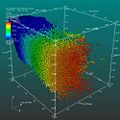Scatter plot
Scatter plot
A scatter plot (also known as a scatterplot, scatter graph, scatter chart, or scatter diagram) is a type of data visualization that uses Cartesian coordinates to display values for typically two variables for a set of data. The data is displayed as a collection of points, each having the value of one variable determining the position on the horizontal axis and the value of the other variable determining the position on the vertical axis.
Overview
Scatter plots are used to observe and show relationships between two numeric variables. The data in a scatter plot are considered to express a trend, correlation, or pattern. If the points are color-coded, an additional variable can be displayed. The scatter plot can also be used to identify other patterns in data, including clusters, outliers, and gaps.
History
The scatter plot was invented in the early 19th century by Sir John F.W. Herschel and Sir Francis Galton. Galton used the scatter plot to study the relationship between two variables and introduced the concept of correlation.
Types of Scatter Plots
- Simple Scatter Plot: Displays values for two variables for a set of data.
- Grouped Scatter Plot: Similar to a simple scatter plot but with data points color-coded to represent a third variable.
- 3D Scatter Plot: Used to display three-dimensional data; the color and size of the points can represent additional variables.
Uses of Scatter Plots
- Correlation Analysis: To determine if there is a relationship between two variables and the strength of the relationship.
- Outlier Detection: To identify data points that significantly differ from the rest of the data.
- Data Clustering: To observe the grouping of data points in the dataset.
Constructing a Scatter Plot
To construct a scatter plot, one variable is plotted along the x-axis, and the other variable is plotted along the y-axis. Each point represents an observation. The position of a point depends on its values along the two axes.
Interpretation
The pattern of the scatter plot can indicate the relationship between the variables:
- A linear pattern suggests a linear relationship.
- A curved pattern suggests a non-linear relationship.
- No pattern suggests no correlation.
Limitations
While scatter plots are useful for identifying trends and patterns, they have limitations:
- They are less effective for large datasets where points can overlap, making it difficult to identify patterns.
- They do not provide a clear way to quantify the relationship between variables.
See Also
This article is a graph theory-related stub. You can help WikiMD by expanding it!
Scatter plot gallery
Transform your life with W8MD's budget GLP-1 injections from $125.
W8MD offers a medical weight loss program to lose weight in Philadelphia. Our physician-supervised medical weight loss provides:
- Most insurances accepted or discounted self-pay rates. We will obtain insurance prior authorizations if needed.
- Generic GLP1 weight loss injections from $125 for the starting dose.
- Also offer prescription weight loss medications including Phentermine, Qsymia, Diethylpropion, Contrave etc.
NYC weight loss doctor appointments
Start your NYC weight loss journey today at our NYC medical weight loss and Philadelphia medical weight loss clinics.
- Call 718-946-5500 to lose weight in NYC or for medical weight loss in Philadelphia 215-676-2334.
- Tags:NYC medical weight loss, Philadelphia lose weight Zepbound NYC, Budget GLP1 weight loss injections, Wegovy Philadelphia, Wegovy NYC, Philadelphia medical weight loss, Brookly weight loss and Wegovy NYC
|
WikiMD's Wellness Encyclopedia |
| Let Food Be Thy Medicine Medicine Thy Food - Hippocrates |
Medical Disclaimer: WikiMD is not a substitute for professional medical advice. The information on WikiMD is provided as an information resource only, may be incorrect, outdated or misleading, and is not to be used or relied on for any diagnostic or treatment purposes. Please consult your health care provider before making any healthcare decisions or for guidance about a specific medical condition. WikiMD expressly disclaims responsibility, and shall have no liability, for any damages, loss, injury, or liability whatsoever suffered as a result of your reliance on the information contained in this site. By visiting this site you agree to the foregoing terms and conditions, which may from time to time be changed or supplemented by WikiMD. If you do not agree to the foregoing terms and conditions, you should not enter or use this site. See full disclaimer.
Credits:Most images are courtesy of Wikimedia commons, and templates, categories Wikipedia, licensed under CC BY SA or similar.
Contributors: Prab R. Tumpati, MD




